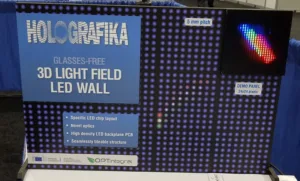Coretronics was in the i-Zone with a near-to-eye light field display. The idea is to create a multi-focal plane display to avoid conflicts with vergence and accommodation. This approach can also use a microlens array to adjust for myopia or hyperopia (-10D to +3D) in the wearer’s eyes so they don’t have to wear their prescription eyeglasses.
The microlens array consists of a matrix of 13 x 7 lenses per eye and uses a Sony 0.7” OLED microdisplay. The group says they will soon move to an LCD display, however. The field of view was 54 degrees and created a 12.4 pixel per degree (PPD) image (low). Two to six layers can be created with an image distance from 10 cm to infinity. It creates a nice compact design, as well (13 x 33 x 22mm). They also implemented a pixel shifting technique using a birefringent material to shift the image a ½ pixel in the diagonal direction (like pixel shifting projectors do) to improve resolution.
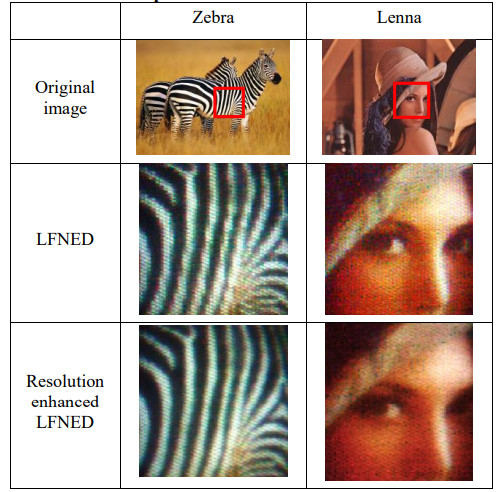
In the future, the group plans to work on a VR module with a FOV of 90 degrees and angular resolution of >20 PPD. For AR, they want to develop a module with 40 degree FOV and > 30 PPD. The prototype was at SID to mainly collect feedback.
Holografika was in the i-Zone to show off a new LED-based light field display. To date, the company has used an array of projectors and a holographically-define screen to create a horizontal only light field display. This is the first time they have shown an LED-based solution.
The company was not disclosing too much about how the system works, but did say it is horizontal parallax only and uses a complex, multi-layer optical system to deliver the light field image. The demo was rather crude using a very small panel with a 5mm pitch and 24 x 24 pixel layout. But it achieved a 70º FOV. When viewing the display from about 10 feet (3 m) away and walking sideways, you can see that the there is clear horizontal parallax as the three colored bars look to be at different distance and their relationship changes with movement.
NTT Service Evolution Laboratories was showing a multi-projector-screen combination that was said to produce a super-multiview 3D stereoscopic image with horizontal parallax only. A set up with six small projectors and their newly designed screen was shown in the i-Zone. Details of the screen design are shown in the graphic.
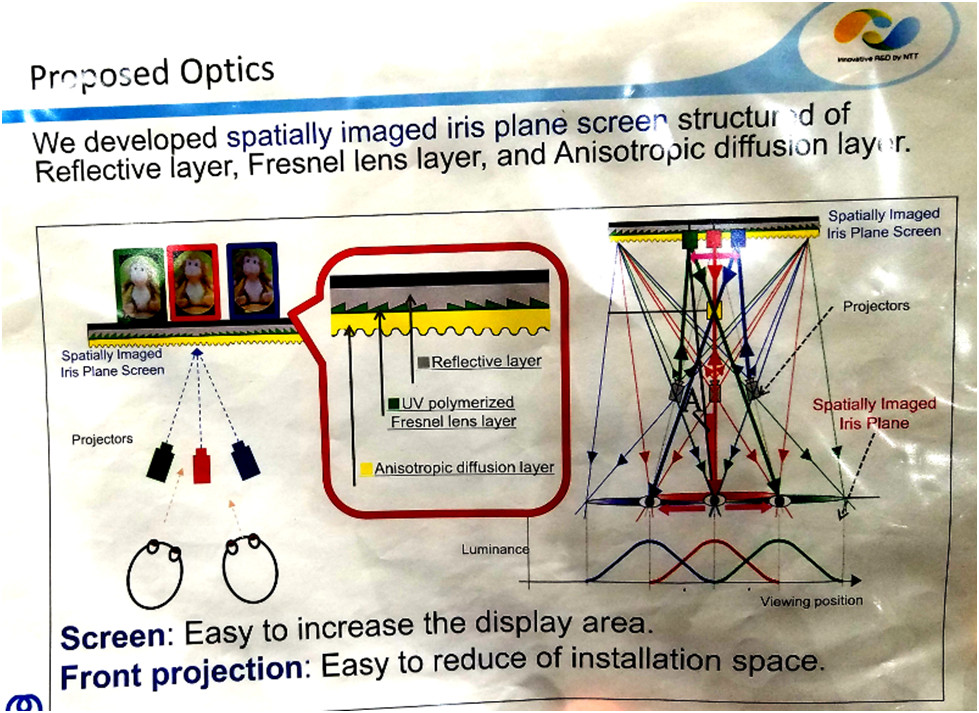
The group was showing the results of their linear blending technology. This was developed to reduce the sharpness or the image transition when moving sideways. They added a “quadrature phase pattern” to the images to take advantage of human visual perception. The result is a smoothing of the images that not only reduces the sharpness of the image transitions, but can reduce the number of projectors needed. Details are in paper 21-1.
BOE showed a 65” auto-stereoscopic 3D with a claimed resolution of 7680 x 4320 but we do not believe it is a conventional RGB type – perhaps RGBW, although BOE was not revealing any details. I did overhear a 3D expert say it was 2K x 2K, but I am unclear if that meant the 3D resolution or the panel resolution. StreamTV showed this panel at CES in a private room. It does use sub-pixel rendering so is definitely not 8K with a conventional RGB stripe architecture.
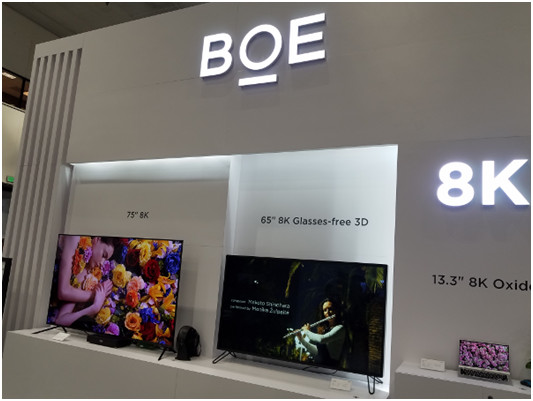
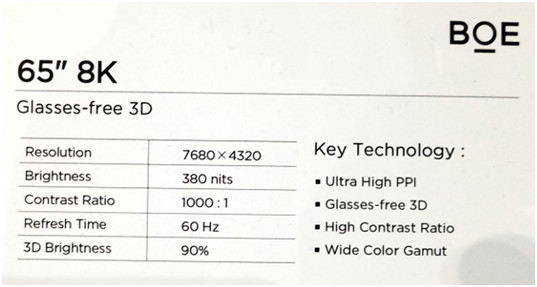
BOE also showed a 75” and 110” 8K models along with a complete 8K cloud strategy. These other displays are believed to use a conventional pixel architecture.
Samsung Display showed their versions of light field displays at SID in their booth in a darkened room dubbed “Future Displays.” Two displays were being shown.
The 5.09” LF display had a resolution of 1440 x 2560, brightness of 350 cd/m², a 30º FOV and 26 views. The 5.77” version seemed to be targeted toward an AR application. Specs were similar (1440 x 2960; 350 cd/m²; 28-degree FOV, 39 views). The difference seemed to be the addition of image tracking to this display.
Unfortunately, no spokesperson was on hand to provide any technical details so we are unclear on the base technology. My impression was that it looked like a super-multiview autostereoscopic display as the content did not help me identify if it has vertical and horizontal parallax and if it solved the vergence-accommodation problem. They were also very dim. Photos could not capture the image very well.
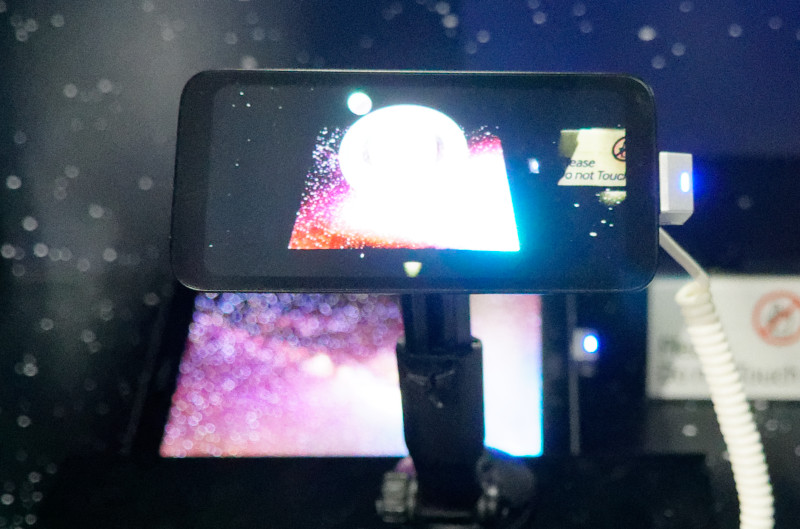 This is the best we could do in capturing an image from the Samsung display. Image:Meko
This is the best we could do in capturing an image from the Samsung display. Image:Meko
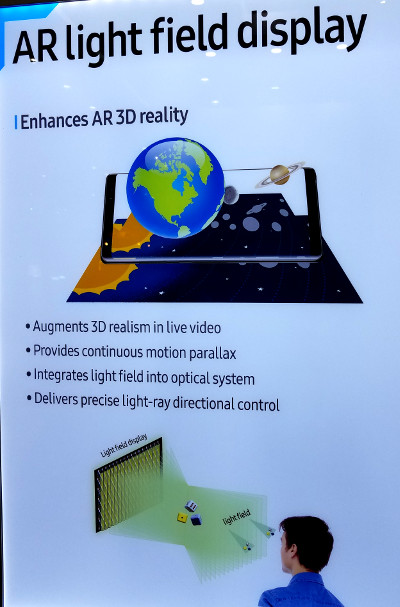
SeeFront was in the German pavilion showing their auto-stereoscopic 3D monitor. This has been an eye-tracked solution, but the company is now not talking about that part, apparently having integrated it into the 32” monitor, which uses a 4K panel. This display produces excellent 3D images (apparently, Lenny Lipton went by and called it the “best 3D he has ever seen”).
The company is having success with their technology especially in casino-based machines. In addition to the 32” monitor, they offer a 15” and 23” versions as well. – CC

